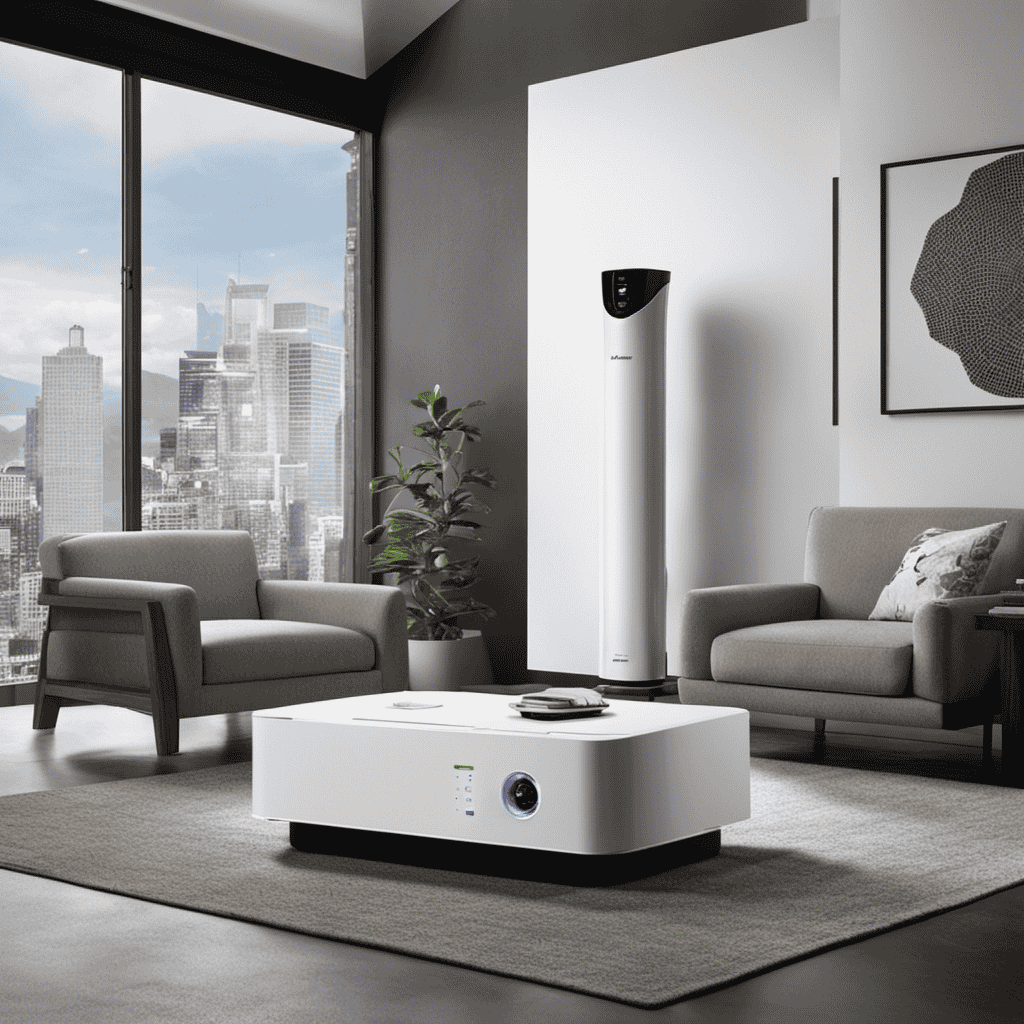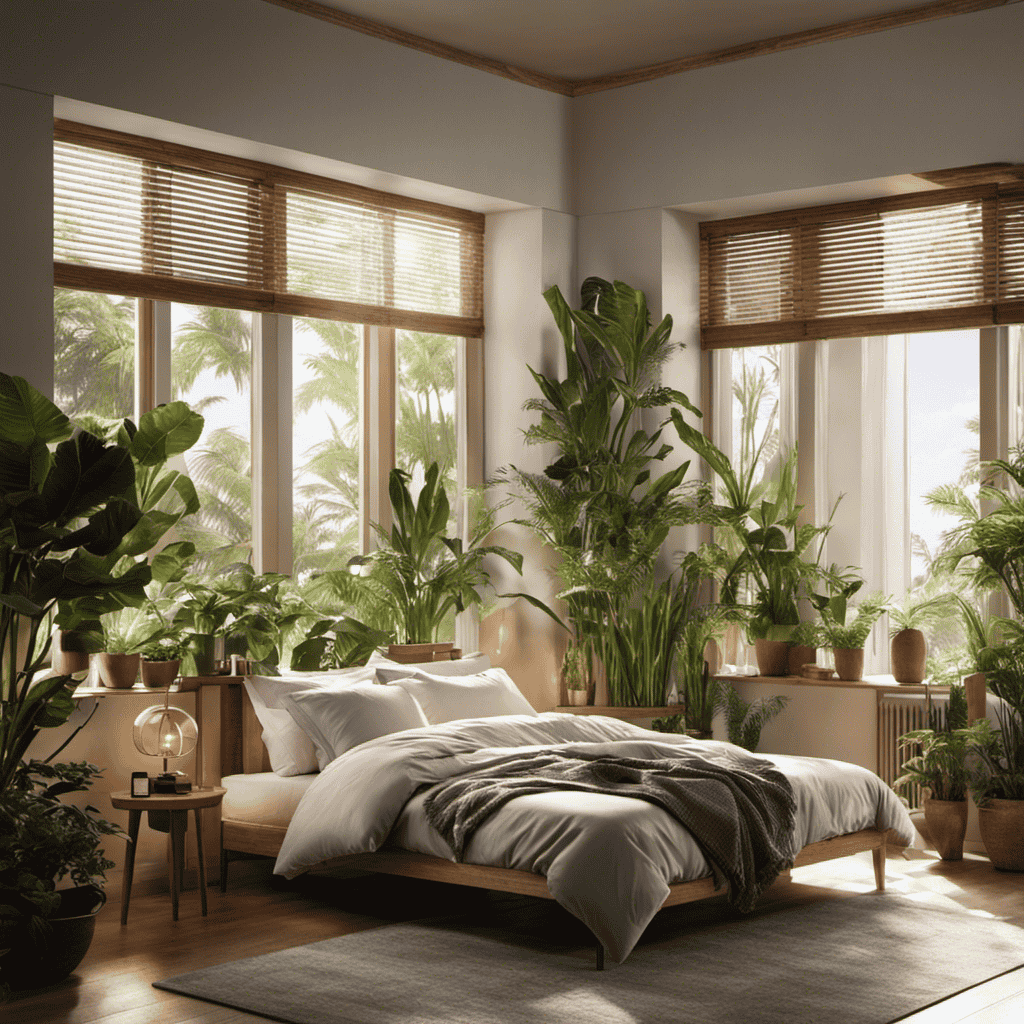As I explore the realm of air purifiers, I am left contemplating: How long should I keep my Levoit air purifier running?
This marvel of modern technology promises to cleanse the air in my home, but for how long should I let it work its magic?
In this article, we will explore the factors to consider, recommended daily usage, and how room size and air quality play a role in determining the optimal running time.
So, let’s embark on this journey and discover the ideal duration to keep our air pure and our lungs happy.
Key Takeaways
- The recommended duration for running a Levoit Air Purifier is at least 8 hours per day for optimal performance.
- Factors such as room size, air pollution level, and specific needs should be analyzed to determine the optimal daily usage of the air purifier, typically ranging from 8-12 hours.
- Regular filter replacements are crucial for the effectiveness of the air purifier, and different models have different recommended replacement intervals.
- Energy consumption can be minimized by running the air purifier in specific rooms or during specific times, adjusting fan speed settings, and using it during off-peak hours for lower electricity rates.
Factors to Consider
When choosing an air purifier, it’s important to consider factors such as room size and air quality concerns. To ensure optimal performance, the recommended duration for running a Levoit air purifier is at least 8 hours per day.
This duration allows the purifier to effectively filter the air in your room and maintain a clean environment. However, if you have specific air quality concerns or live in an area with high pollution levels, it may be beneficial to run the air purifier for longer periods, such as overnight or throughout the day.
By following the recommended duration, you can ensure that the air purifier is continuously working to remove pollutants and allergens from your space.
Now, let’s move on to the recommended daily usage of the Levoit air purifier.
Recommended Daily Usage
When considering the optimal usage duration of a Levoit air purifier, several factors come into play. These factors include the size of the room, the level of air pollution, and the specific needs of the individuals in the space.
Additionally, energy consumption considerations should be taken into account to ensure efficient and cost-effective usage of the air purifier. By analyzing these factors, we can determine the recommended daily usage of the Levoit air purifier for maximum effectiveness and energy efficiency.
Optimal Usage Duration
The optimal duration to run the Levoit air purifier is typically around 8-12 hours a day. This recommended duration ensures that the air purifier operates at its peak performance, effectively removing airborne pollutants and improving indoor air quality.
Running the air purifier for this length of time allows it to cycle the air multiple times, capturing and trapping contaminants such as dust, pollen, pet dander, and mold spores. It also helps to eliminate odors and freshen the air in your home.
By adhering to the recommended duration, you can maximize the efficiency and effectiveness of the Levoit air purifier, ensuring that you and your family breathe in clean and healthy air.
Now, let’s explore the factors that can affect the usage of the air purifier.
Factors Affecting Usage
To maximize the efficiency of your air purifier, it’s important to consider various factors that can affect its usage.
Two important factors to consider are the recommended filter replacements and the impact on your electricity bill.
Regularly replacing the filters is crucial for maintaining the air purifier’s effectiveness in removing pollutants from the air. Different models have different recommended filter replacement intervals, so it’s essential to consult the user manual or manufacturer’s guidelines for your specific air purifier.
Additionally, running an air purifier continuously can increase your electricity bill. To minimize the impact on your energy consumption, you can consider running the air purifier in specific rooms or during times when pollutants are most likely to be present.
Transitioning into the next section, let’s now explore energy consumption considerations when using an air purifier.
Energy Consumption Considerations
One way to minimize the impact on your energy bill is by running the air purifier only in specific rooms or during specific times. This energy-saving tip allows you to focus the air purification process where it is most needed, reducing unnecessary energy consumption.
Another cost consideration is to adjust the fan speed settings on the air purifier. Lower fan speeds consume less energy while still providing effective air cleaning.
Additionally, consider using the air purifier during off-peak hours when electricity rates are typically lower. This simple adjustment can help further reduce energy costs.
Lastly, keep in mind that air purifiers with energy-saving features, such as auto shut-off timers or sensors that detect air quality levels, can be more efficient and cost-effective in the long run.
Room Size and Air Quality
When it comes to optimizing room sizes for air purification, there are several key factors to consider.
One important factor is the size of the room itself, as a purifier may be more or less effective depending on the room’s dimensions.
Additionally, the effectiveness of an air purifier can be measured using various metrics, such as the Clean Air Delivery Rate (CADR) or the percentage of airborne particles removed.
Lastly, the duration for air purification will vary depending on the level of air pollution and the desired air quality, with some purifiers offering different speed settings and timers to accommodate different needs.
Optimal Room Sizes
For optimal room sizes, you should consider the square footage of the area where you plan to use the Levoit air purifier. The purification effectiveness of the Levoit air purifier is directly influenced by the size of the room it is placed in.
The air purifier is designed to effectively clean the air in rooms up to a certain square footage. This means that if you place the air purifier in a room that is too large, it may not be able to effectively purify the air. On the other hand, if you place it in a room that is too small, the air purifier may be too powerful and could cause discomfort.
Therefore, it is important to choose a Levoit air purifier that is compatible with the size of your room to ensure optimal purification effectiveness.
Purifier Effectiveness Measurement
To determine how well the device works, you can measure the effectiveness of the purifier by analyzing the air quality before and after using it.
Air purifier effectiveness measurement is crucial in understanding the device’s performance and its ability to improve indoor air quality.
The first step is to assess the initial air quality, which can be done using an air quality monitor or by observing any visible pollution particles in the air.
Next, run the purifier for a specific duration, typically recommended by the manufacturer, to allow it to clean the air thoroughly.
After the designated time, retest the air quality to determine the improvement.
This measurement process helps gauge the efficiency of the purifier and ensures optimal purification for a healthier living environment.
Duration for Air Purification
After measuring the effectiveness of the Levoit air purifier, it’s important to determine how long to run it for optimal air purification. Adjusting the run time of the air purifier can help maximize its benefits.
The duration for air purification depends on various factors such as room size, air quality, and the specific needs of the user. In general, running the air purifier continuously or for longer periods can result in cleaner air. However, it’s also important to consider energy consumption and noise levels.
It is recommended to start by running the air purifier for a few hours each day and gradually adjusting the run time based on air quality improvements and personal preferences. Regular maintenance and filter replacements are also crucial to maintain the effectiveness of the air purifier.
Allergies and Sensitivities
If you have allergies or sensitivities, running the Levoit air purifier can help alleviate symptoms. The air we breathe indoors can contain pollutants and allergens, many of which come from common building materials. These materials can release volatile organic compounds (VOCs) that can negatively impact respiratory health.
The Levoit air purifier is equipped with a true HEPA filter that can capture particles as small as 0.3 microns, including dust, pollen, pet dander, mold spores, and VOCs. By continuously running the air purifier, it can effectively remove these allergens and pollutants from the air, providing a cleaner and healthier environment for those with allergies or sensitivities.
Now, let’s explore the purpose of use for the Levoit air purifier.
Purpose of Use
When considering the purpose of using it, you’ll find that the Levoit air purifier can help improve the air quality in your home.
This device is designed to remove airborne pollutants such as dust, smoke, pet dander, and pollen from the air.
The air purifier works by pulling in air through its filters and trapping these particles, releasing clean air back into the room.
One important aspect to consider when using the Levoit air purifier is filter replacement. The filters in the device need to be replaced regularly to maintain optimal performance. This ensures that the air purifier continues to effectively remove pollutants from the air.
Additionally, the Levoit air purifier is equipped with user-friendly features, such as a timer and multiple fan speeds, allowing you to customize its operation to suit your preferences and needs.
Energy Efficiency
To maximize energy efficiency, you can adjust the fan speed on the Levoit air purifier. By reducing the fan speed, you can lower the energy consumption of the device while still maintaining its effectiveness. This is one of the energy saving tips that can contribute to a cost-effective operation of the air purifier.
Additionally, it is recommended to use the air purifier only when necessary, such as during periods of high pollution or when there are specific indoor air quality concerns. This approach ensures that the device is used efficiently and minimizes unnecessary energy usage.
Now, let’s discuss another important aspect of the Levoit air purifier: its noise level.
Noise Level
When it comes to air purifiers, one important factor to consider is the noise level. Some people prefer a quiet environment and would opt for a purifier that operates silently.
Others may not mind a bit of background noise and would be willing to sacrifice quietness for a more powerful unit.
In this discussion, we will compare the noise levels of different air purifiers to help you decide which one is right for you.
Quiet or Disruptive
Whether you find it quiet or disruptive, the Levoit air purifier can effectively clean the air in your home.
The Levoit air purifier is designed to operate quietly, ensuring minimal disturbance to your daily activities. With its advanced noise reduction techniques, this air purifier provides a peaceful environment while efficiently removing airborne pollutants.
The quiet operation of the Levoit air purifier is achieved through the use of high-quality fans and sound-absorbing materials. These components work together to reduce noise levels, allowing you to enjoy cleaner air without the distraction of loud machinery.
Whether you are working, sleeping, or simply relaxing, the Levoit air purifier ensures a serene environment while improving the air quality in your home.
Noise Level Comparison
You’ll notice a significant difference in noise levels between the Levoit air purifier and other models on the market. The Levoit air purifier is specifically designed for quiet operation, ensuring a peaceful and undisturbed environment.
Here’s a noise level comparison to give you a better understanding:
-
Levoit Air Purifier: With advanced noise reduction technology, the Levoit air purifier operates at a whisper-quiet sound level of only 24 decibels. You can enjoy clean air without any disturbance, even while sleeping or working.
-
Other Air Purifiers: Many other air purifiers on the market produce noise levels ranging from 50 to 70 decibels, which is comparable to the sound of a normal conversation or a vacuum cleaner.
-
Impact on Daily Life: The low noise level of the Levoit air purifier ensures minimal disruption to your daily activities, allowing you to focus, relax, or sleep without any disturbances.
-
Considerations: When choosing an air purifier, it’s important to prioritize quiet operation to create a calm and peaceful environment in your home or workspace.
Maintenance and Filter Change
To keep your Levoit air purifier running efficiently, make sure to regularly maintain it and change the filters.
Maintenance tips include cleaning the outer surface of the purifier with a soft cloth and mild detergent. Avoid using harsh chemicals or abrasive materials that could damage the device.
Additionally, it is important to change the filters according to the recommended frequency. The frequency of filter replacement depends on various factors such as the air quality in your area, the level of pollution, and the usage of the air purifier.
As a general guideline, it is recommended to replace the filters every 6 to 8 months. However, it is essential to consult the user manual or the manufacturer’s guidelines for specific instructions regarding the filter replacement frequency for your Levoit air purifier.
Sleep Mode and Nighttime Usage
During nighttime, the air purifier can be set to sleep mode for a quieter operation. This mode reduces noise levels, allowing for a peaceful sleep environment. Furthermore, utilizing sleep mode can have several benefits for sleep quality and overall health.
-
Improved sleep quality: By removing airborne pollutants such as dust, pet dander, and pollen, the air purifier creates a cleaner and healthier sleeping environment, promoting better sleep quality.
-
Allergy relief: Reduced exposure to allergens can alleviate symptoms such as sneezing, coughing, and congestion, leading to a more restful sleep.
-
Respiratory health: Eliminating airborne contaminants can help prevent respiratory issues, such as asthma attacks or respiratory infections, which can disrupt sleep patterns.
-
Relaxation and stress reduction: Breathing cleaner air can contribute to a feeling of relaxation, reducing stress levels and promoting a more peaceful night’s sleep.
By optimizing sleep quality and promoting a healthier environment, the air purifier’s sleep mode offers significant health benefits.
Transitioning to the next section, we will discuss the running time required to effectively target specific airborne contaminants.
Running Time for Specific Airborne Contaminants
Eliminating specific airborne contaminants may require a certain amount of running time for optimal effectiveness. The recommended filter types for different contaminants are High-Efficiency Particulate Air (HEPA) filters, activated carbon filters, and ionizers.
HEPA filters are effective in removing particles like dust, pollen, and pet dander. Activated carbon filters are best for eliminating odors and volatile organic compounds (VOCs). Ionizers use charged particles to attract and remove contaminants from the air.
The running time needed to eliminate airborne contaminants depends on factors such as the size of the room and the level of pollution. It is recommended to run the air purifier continuously for a few hours a day or as needed. However, it is important to consider the impact on the electricity bill when running the air purifier for extended periods.
Adjusting Run Time for Different Seasons
Adjusting the run time for different seasons can help optimize the effectiveness of air purifiers in removing airborne contaminants. By considering the specific climate and pollution levels, you can ensure that your air purifier runs for an appropriate duration to achieve the best results.
Here are some key factors to consider when adjusting the run time:
-
Climate: In hot and humid climates, it’s recommended to run the air purifier for longer periods of time, as these conditions can promote the growth of mold and other allergens. Conversely, in colder climates with less humidity, running the air purifier for shorter durations may be sufficient.
-
Pollution levels: If you live in an area with high pollution levels, such as near busy roads or industrial areas, it’s advisable to run the air purifier for longer to continuously filter out the pollutants. In areas with lower pollution levels, shorter run times may be adequate.
What is the recommended runtime for the Levoit Air Purifier?
The recommended running Levoit air purifier time varies depending on the size of the room and the air quality. For smaller rooms or areas with mild air pollution, running the Levoit air purifier for a few hours each day may be sufficient. In larger spaces or areas with more pollution, it may be necessary to run the purifier for longer periods of time.
Frequently Asked Questions
Can the Levoit Air Purifier Remove Odors From the Air?
Yes, the Levoit air purifier is effective in removing odors from the air. Its high-quality filter can capture and eliminate various odors. The lifespan of the filter depends on usage and air quality.
Is It Safe to Run the Levoit Air Purifier Continuously for Long Periods of Time?
Running the Levoit air purifier continuously has both pros and cons. On one hand, it ensures constant air purification. On the other hand, it may cause increased energy consumption. To maintain optimal performance, regular filter replacement is essential.
Can the Levoit Air Purifier Be Used in Large Commercial Spaces?
The Levoit Air Purifier is suitable for commercial applications and can effectively control air quality. Its usage time is dependent on the specific needs of the space and the air quality conditions.
Does the Levoit Air Purifier Come With a Warranty?
The Levoit Air Purifier does come with a warranty, providing coverage for a specified duration. It’s always reassuring to know that your investment is protected.
Can the Levoit Air Purifier Be Controlled Remotely Through a Smartphone App?
Yes, the Levoit Air Purifier can be controlled remotely through a smartphone app. Its smartphone compatibility allows users to easily adjust settings and monitor air quality from anywhere in the house.
Conclusion
In conclusion, the running time of the Levoit air purifier depends on various factors such as room size, air quality, allergies, and purpose of use.
It is recommended to run the purifier daily to ensure optimal air purification. Regular maintenance and filter changes are crucial for its efficiency.
Additionally, adjusting the run time for different seasons and specific airborne contaminants can further enhance its performance.
So, set the schedule, sleep soundly, and let the Levoit air purifier purify your air with precision and peace.










